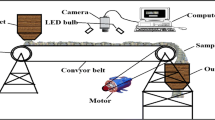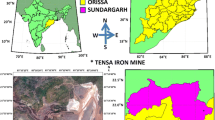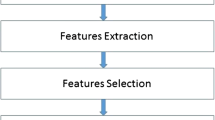Abstract
The aim of the present study is to analysing the effect of water absorption on iron ore samples in the performances of SVM-based machine vision system. Two types of SVM-based machine vision system (classification and regression) were designed and developed, and performances were compared with dry and wet ore sample images. The images of the ore samples were captured in both the conditions (wet and dry) to examine the proposed model performance. A total of 280 image features were extracted and optimised using sequential forward floating selection (SFFS) algorithm for model development. The iron ore samples were collected from an Indian iron ore mine (Guamine), and image capturing system was fabricated in the laboratory for executing the proposed study. The results indicated that a different set of optimised features obtained for dry and wet sample images in both the models (classification and regression). Furthermore, the performance of both the models with dry sample images was found to be relatively better than the wet sample images.
Similar content being viewed by others
References
C. Duchesne, “Multivariate image analysis in mineral processing,” in Advanced Control and Supervision of Mineral Processing Plants, Ed. by D. Sbárbaro and R. del Villar, Advances in Industrial Control (Springer, London, 2010), pp. 85–142.
H. B. Mall and N. da Vitoria Lobo, “Determining wet surfaces from dry,” in Proc. IEEE International Conference on Computer Vision (Cambridge, MA, USA, 1995) (IEEE Comput. Soc., 1995), pp. 963–968.
T. Teshima, H. Saito, M. Shimizu, and A. Taguchi, “Classification of wet/dry area based on the mahalanobis distance of feature from time space image analysis,” in Proc. 11th IAPR Conf. on Machine Vision Applications (MVA2009) (Yokohama, Japan, 2009), pp. 467–470.
J. Lekner and M. C. Dorf, “Why some things are darker when wet,” Appl. Opt. 27 (7), 1278–1280 (1988).
A. Ångström, “The albedo of various surfaces of ground,” Geograf. Ann. 7, 323–342 (1925).
K. R. P. Petersen, C. Aldrich, and J. S. J. Van Deventer, “Analysis of ore particles based on textural pattern recognition,” Miner. Eng. 11 (10), 959–977 (1998).
J. Tessier, C. Duchesne, and G. Bartolacci, “A machine vision approach to on-line estimation of run-of-mine ore composition on conveyor belts,” Miner. Eng. 20 (12), 1129–1144 (2007).
M. Z. Abdullah, J. Mohamad-Saleh, A. S. Fathinul-Syahir, B. M. N. Mohd-Azemi, “Discrimination and classification of fresh-cut starfruits (Averrhoa carambola L.) using automated machine vision system,” J. Food Eng. 76 (4), 506–523 (2006).
V. J. Davidson, J. Ryks, and T. Chu, “Fuzzy models to predict consumer ratings for biscuits based on digital image features,” IEEE Trans. Fuzzy Syst. 9 (1), 62–67 (2001).
B. Coifman, D. Beymer, P. McLauchlan, and J. Malik, “A real-time computer vision system for vehicle tracking and traffic surveillance,” Transp. Res. Part C: Emerging Technol. 6 (4), 271–288 (1998).
V. Karathanassi, C. Iossifidis, and D. Rokos, “Application of machine vision techniques in the quality control of pharmaceutical solutions,” Comput. Ind. 32 (2), 169–179 (1996).
C. Shang and D. Barnes, “Fuzzy-rough feature selection aided support vector machines for Mars image classification,” Comput. Vision Image Understanding 117 (3), 202–213 (2013).
C. Perez, A. Casali, G. Gonzalez, G. Vallebuona, and R.Vargas, “Lithological composition sensor based on digital image feature extraction, genetic selection of features and neural classification,” in Proc. 1999 Int. Conf. on Information Intelligence and Systems (Bethesda, MD, USA, 1999) (IEEE Comput. Soc., 1999), pp. 236–241.
J. Courbon, Y. Mezouar, N. Guénard, and P. Martinet, “Vision-based navigation of unmanned aerial vehicles,” Control Eng. Pract. 18 (7), 789–799 (2010).
S. Al-Thyabat and N. J. Miles, “An improved estimation of size distribution from particle profile measurements,” Powder Technol. 166 (3), 152–160 (2006).
N. Sadr-Kazemi and J. Cilliers, “An image processing algorithm for measurement of flotation froth bubble size and shape distributions,” Miner. Eng. 10 (10), 1075–1083 (1997).
A. K. Patel and S. Chatterjee, “Computer vision-based limestone rock-type classification using probabilistic neural network,” Geosci. Front. 7 (1), 53–60 (2016).
S. Chatterjee and A. Bhattacherjee, “Genetic algorithms for feature selection of image analysis-based quality monitoring model: An application to an iron mine,” Eng. Appl. Artif. Intell. 24 (5), 786–795 (2011).
Z. Zhang, J. Yang, Y. Wang, D. Dou, and W. Xia, “Ash content prediction of coarse coal by image analysis and GA-SVM,” Powder Technol. 268, 429–435 (2014).
C. A. Perez, P. A. Estévez, P. A. Vera, L. E. Castillo, C. M. Aravena, D. A. Schulz, and L. E. Medina, “Ore grade estimation by feature selection and voting using boundary detection in digital image analysis,” Int. J. Miner. Process. 101 (1–4), 28–36 (2011).
C. A. Perez, J. A. Saravia, C. F. Navarro, D. A. Schulz, C. M. Aravena, and F. J. Galdames, “Rock lithological classification using multi-scale Gabor features from sub-images, and voting with rock contour information,” Int. J. Miner. Process. 144, 56–64 (2015).
A. K. Patel, S. Chatterjee, and A. K. Gorai, “Development of machine vision-based ore classification model using support vector machine (SVM) algorithm,” Arabian J. Geosci. 10 (5), Article 107 (2017).
S. Chatterjee, A. Bhattacherjee, B. Samanta, and S. K. Pal, “Image-based quality monitoring system of limestone ore grades,” Comput. Ind. 61 (5), 391–408 (2010).
A. Casali, G. Gonzalez, G. Vallebuona, C. Perez, and R. Vargas, “Grindability soft-sensors based on lithological composition and on-line measurements,” Miner. Eng. 14 (7), 689–700 (2001).
J. M. Oestreich, W. K. Tolley, and D. A. Rice, “The development of a color sensor system to measure mineral compositions,” Miner. Eng. 8 (1–2), 31–39 (1995).
V. Singh and S. M. Rao, “Application of image processing and radial basis neural network techniques for ore sorting and ore classification,” Miner. Eng. 18 (15), 1412–1420 (2005).
S. Chatterjee, “Vision-based rock-type classification of limestone using multi-class support vector machine,” Appl. Intell. 39 (1), 14–27 (2013).
X. Meng, “Scalable simple random sampling and stratified sampling,” in Proc. 30th Int. Conf. on Machine Learning (ICML’13) (Atlanta, GA, USA, 2013), PMLR 28 (3), 531–539 (2013).
S. L. Jackson, Research Methods and Statistics: A Critical Thinking Approach, 5th ed. (Cengage Learning, Boston, MA, 2015).
D. D. Sarma, Geostatistics with Applications in Earth Sciences, 2nd ed. (Springer, Dordrecht, 2009).
R. C. Gonzalez and R. E. Woods, Digital Image Processing, 3rd ed. (Prentice Hall, Upper Saddle River, NJ, 2008).
Y. Zhao, D. Li, and Z. Li, “Performance enhancement and analysis of an adaptive median filter,” in Proc. 2007 Second Int. Conf. on Communications and Networking in China (ChinaCom’07) (Shanghai, China, 2007), IEEE, pp. 651–653.
M. G. Forero-Vargas and L. J. Delgado-Rangel, “Fuzzy filters for noise removal,” in Fuzzy Filters for Image Processing, Ed. by M. Nachtegael, D. Van der Weken, E. E. Kerre, and D. Van De Ville, Studies in Fuzziness and Soft Computing (Springer, Berlin, Heidelberg, 2003), Vol. 122, pp. 3–24.
P. S. J. Sree, P. Kumar, R. Siddavatam, and R. Verma, “Salt-and-pepper noise removal by adaptive medianbased lifting filter using second-generation wavelets,” Signal, Image Video Process. (SIViP) 7 (1), 111–118 (2013).
A. Kumar, “Deblurring of motion blurred images using histogram of oriented gradients and geometric moments,” Signal Process. Image Commun. 55, 55–65 (2017).
S. Tang, W. Gong, W. Li, and W. Wang, “Non-blind image deblurring method by local and nonlocal total variation models,” Signal Process. 94, 339–349 (2014).
L. P. Yaroslavsky, “Fast transforms in image processing: Compression, restoration, and resampling,” Adv. Electr. Eng. 2014, Article ID 276241, 23 pages (2014).
H. F. Harmuth, Transmission of Information by Orthogonal Functions (Springer, Berlin, Heidelberg, 1970).
N. Ahmed, T. Natarajan, and K. R. Rao, “Discrete cosine transform,” IEEE Trans. Comput. C-23 (1), 90–93 (1974).
J. G. Daugman, “Uncertainty relation for resolution in space, spatial frequency, and orientation optimized by two-dimensional visual cortical filters,” J. Opt. Soc. Am. A. 2 (7), 1160–1169 (1985).
J. G. Daugman, “Two-dimensional spectral analysis of cortical receptive field profiles,” Vision Res. 20 (10), 847–856 (1980).
I. Daubechies, “Orthonormal bases of compactly supported wavelets,” Commun. Pure Appl. Math. 41 (7), 909–996 (1988).
I. Daubechies, “Where do wavelets come from? A personal point of view,” Proc. IEEE 84 (4), 510–513 (1996).
M. Kudo and J. Sklansky, “Comparison of algorithms that select features for pattern classifiers,” Pattern Recogn. 33 (1), 25–41 (2000).
J. Schenk, M. Kaiser, and G. Rigoll, “Selecting features in on-line handwritten whiteboard note recognition: SFS or SFFS?”, in Proc. 10th Int. Conf. on Document Analysis and Recognition (ICDAR 2009) (Barcelona, Spain, 2009) (IEEE Comput. Soc., 2009), p. 1251–1254.
E. Dougherty, J. Hua, and C. Sima, “Performance of Feature Selection Methods,” Curr. Genomics 10 (6), 365–374 (2009).
V. N. Vapnik, The Nature of Statistical Learning Theory (Springer, New York, 1995).
V. N. Vapnik, “An overview of statistical learning theory,” IEEE Trans. Neural Networks 10 (5), 988–999 (1999).
S. Raghavendra N. and P. C. Deka, “Support vector machine applications in the field of hydrology: A review,” Appl. Soft Comput. 19, 372–386 (2014).
G. Mountrakis, J. Im, and C. Ogole, “Support vector machines in remote sensing: A review,” ISPRS J. Photogramm. Remote Sens. 66 (3), 247–259 (2011).
S. Rajasekaran, S. Gayathri, and T. L. Lee, “Support vector regression methodology for storm surge predictions,” Ocean Eng. 35 (16), 1578–1587 (2008).
G. Czibula, I. G. Czibula, and R. D. Gaceanu, “A support vector machine model for intelligent selection of data representations,” Appl. Soft Comput. 18, 70–81 (2014).
R. M. Barbosa, E. S. de Paula, A. C. Paulelli, A. F. Moore, J. M. O. Souza, B. L. Batista, A. D. Campiglia, and F. Barbosa, “Recognition of organic rice samples based on trace elements and support vector machines,” J. Food Compos. Anal. 45, 95–100 (2016).
L. Khedher, J. Ramírez, J. M. Górriz, A. Brahim, and F. Segovia, “Early diagnosis of Alzheimer’s disease based on partial least squares, principal component analysis and support vector machine using segmented MRI images,” Neurocomput. 151, Part 1, 139–150 (2015).
Y. Liu, H. Wang, H. Zhang, and K. Liber, “A comprehensive support vector machine-based classification model for soil quality assessment,” Soil Tillage Res. 155, 19–26 (2016).
Y. Tian, M. Fu, and F. Wu, “Steel plates fault diagnosis on the basis of support vector machines,” Neurocomput. 151, Part 1, 296–303 (2015).
R. Rifkin, S. Mukherjee, P. Tamayo, et al. “An analytical method for multiclass molecular cancer classification,” SIAM Rev. 45 (4), 706–723 (2003).
X. Xi, A.-N. Poo, and S. Chou, “Support vector regression model predictive control on a HVAC plant,” Control Eng. Pract. 15 (8), 897–908 (2007).
O. Ivanciuc, “Applications of support vector machines in chemistry,” in Reviews in Computational Chemistry, Ed. by K. B. Lipkowitz and T. R. Cundari, Vol. 23 (Wiley, New York, 2007), pp. 291–400.
R. Ranawana and V. Palade, “Multi-Classifier Systems: Review and a roadmap for developers,” Int. J. Hybrid Intell. Syst. 3 (1), 35–61 (2006).
M. Sokolova and G. Lapalme, “A systematic analysis of performance measures for classification tasks,” Inf. Process. Manage. 45 (4), 427–437 (2009).
Author information
Authors and Affiliations
Corresponding authors
Additional information
The article is published in the original.
Ashok Kumar Patel completed his PhD in the field of machine vision application in mine systems in the Department of Mining Engineering, National Institute of Technology, Rourkela. After completion of B.Tech. and M.Tech. in Computer Science and Engineering, he had worked as a PhD scholar in NIT Rourkela during 2013 to 2017. Currently, he has been working as an Assistant Professor in Department of Computer Science and Engineering, Koneru Lakshmaiah Education Foundation, AP, India.
Snehamoy Chatterjee is faculty in the Department of Geological and Mining Engineering and Sciences, Michigan Technological University, USA. Earlier he served as an Assistant Professor in Department of Mining Engineering, NIT Rourkela. He did his BE in Mining Engineering in 2000 and ME in Mining Engineering in 2002 from IIEST, Shibpur. He completed his PhD in 2007 from IIT Kharagpur, India. He had served as a post-doctoral Fellow at the University of Alaska, Fairbanks, USA, and McGill University, Canada. He has published a number of technical papers in various journals. His research areas include geostatistics, machine vision system.
Amit Kumar Gorai did his B.E. and M.E. in Mining Engineering from IIEST, Shibpur and PhD in Environmental Science and Engineering from IIT (ISM) Dhanbad. For the last 10 years, he has been involved in teaching and research in the field of mine environment. He is currently working as an Associate Professor in the Department of Mining Engineering, NIT, Rourkela. He has to his credit many publications in various National and International Journals. He has also received the Young Scientist Research Grant from SERB, New Delhi, Raman Postdoctoral Fellowship Award under Indo-US Knowledge Initiative from UGC, New Delhi, and Endeavour Executive Fellowship of Australian Government.
Rights and permissions
About this article
Cite this article
Patel, A.K., Chatterjee, S. & Gorai, A.K. Effect on the Performance of a Support Vector Machine Based Machine Vision System with Dry and Wet Ore Sample Images in Classification and Grade Prediction. Pattern Recognit. Image Anal. 29, 309–324 (2019). https://doi.org/10.1134/S1054661819010097
Received:
Revised:
Accepted:
Published:
Issue Date:
DOI: https://doi.org/10.1134/S1054661819010097




